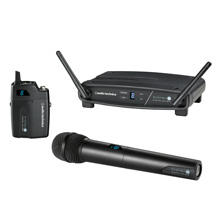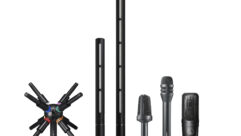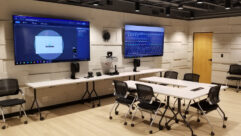

Audio-Technica BP894 MicroSet and System 10 Review
Jun 17, 2014 3:22 PM, Reviewer: John McJunkin
A headworn mic and digital wireless solution for lecture, worship, broadcast, and theater applications.
As both headworn mic technology and wireless technology march forward, it’s hard to fathom that it could get much better. For many years now, we’ve had access to some truly excellent products to help us get the job done. Audio-Technica (A-T) has introduced its BP894 headworn mic, and prior to that, its System 10 wireless, which represents the manufacturer’s first incursion into the digital wireless domain. I was sent evaluation units for both products: BP892cW, ATW1101 body-pack system, and ATW-1102 handheld mic system.
The BP894 headworn mic introduces a 180-degree swiveling mic element, which allows the mic to be placed on either side of the head. It resembles A-T’s previous BP-series headworn mics in terms of its earpiece, cable, and boom. The boom is roughly 4.25in. in length and 0.04in. in diameter. The earpiece is flexible molded plastic. The cable is permanently attached to the earpiece, which is one of my very few quibbles about these mics; I would prefer a detachable cable for easier replacement, but it’s certainly not a deal-breaker. The mic element is about a 1/4in. long and 0.11in. in diameter. It features a white dot to indicate the direction of the cardioid lobe, as if listening wouldn’t suffice. On the other hand, in an application that requires a quick setup, it’s reassuring to know that the mic is pointed in the right direction before the speaker or vocalist makes a sound.
The ATW-R1100 receiver is a bit smaller and more artsy than its predecessors, with an attractive front panel shaped like a long oval truncated at both ends. The features of the front panel are dead simple: two antennas, a system ID button, a pairing button, a seven-segment numerical LED display, and two LEDs to indicate pairing and level peaking. The rear panel is just as simple: 1/4in. unbalanced output, XLR balanced output, output level knob, and DC power inlet with a cable strain relief. The ATW-T1001 UniPak transmitter is roughly the size of a deck of cards with a front panel that slides off to reveal the dual-AA battery compartment, a pairing button, and a recessed level control, complete with a tweaker tool with which to adjust it. Above the front panel is a seven-segment numerical LED display, and on top is an antenna, a power/mute button, the mic input connector, and a multipurpose LED that indicates power, muting, and battery status. A belt clip is on the back.
The ATW-T1002 handheld transmitter features the same under-the-hood items as the UniPak: a compartment for two AA batteries, a pairing button, level control (with included tweaker tool), a seven-segment numerical LED display, and multipurpose LED. All but the display LEDs are concealed under the screw-off lower half of the handheld unit. There’s one particular feature of this mic that I really like: the power/mute button is literally at the end of the non-business end of the mic. No button or slider switch for a vocalist or speaker to accidentally mute or turn off. The pushbutton is also recessed just a bit, so while it’s not impossible to make an inadvertent mistake, it’s much less likely. This is clever and much appreciated.
I have put headworn mics from numerous manufacturers on lecturers, pastors, and vocalists over the years, and Audio-Technica has been a staple for me. I have used mics from the BP series for an array of applications, and they’ve always served me well. I was excited to hear that they had developed this aimable cardioid, granting the flexibility of putting the boom on either side of the user’s face and delivering the additional gain before feedback that a cardioid can offer. I had also been excited to evaluate Audio-Technica’s digital System 10, having had success with the company’s VHF and UHF systems in the past. The BP894’s frequency response is full-bandwidth, from 20Hz to 20kHz, and is quite flat, tapering down from the 0dB line to -5dB between 15kHz and 20kHz, and delivering excellent low-end response. (Note that the wired version includes an 18dB/octave high-pass filter cornered at 80Hz.) The only notable departure from an absolutely flat response otherwise is a broad bump that climbs gently from 0dB at 1.5kHz up to +6dB at around 6.5kHz, and then gently back down to the zero line at roughly 15kHz. The intelligibility of the human voice is right in that range, so the mic delivers truly clear speech and can work quite well for singing vocals too, so long as the engineer is aware of that curve.
I had hoped that I’d be as pleased with the System 10 wireless as I was with the mic, and after spending time with it, I found that I was. Digital wireless continues to become more and more prevalent, and Audio-Technica’s very reasonably priced digital system is very welcome. It’s limited to just eight channels, but its simplicity and quality make it very attractive for applications that do not require anything more. The system ensures uninterrupted quality by leveraging three different kinds of diversity; frequency, time, and space. I won’t wade out into the technical weeds on this, but the result is indeed very solid, constant transmission and reception of the signal.
I put both microphones and the wireless system through their paces with both male and female voices, spoken and sung, in environments ranging from a small, intimate interior to outdoors in the open air. The wireless system was fantastic, with the noise floor way down, and as is expected with digital wireless, no audible RF interference—dead clear. I got both transmitters well beyond the published operating range of 100ft. with no ill effect at all. The great benefit of the BP894 over its predecessors in the BP series is its cardioid element, granting greater gain before feedback as a result of directionality. I was very impressed with the off-axis rejection of this mic; it really increased the GBF I was able to achieve. To my ear, it sounded a touch mid-rangey, but with a 3dB scoop centered at 1.5kHz and with a moderately broad Q, it sounded very good. The handheld mic required virtually no EQ at all—again, just the tiniest bit of scooping in the mids. It felt just like any other handheld, delivering the proximity effect that speakers and vocalists expect. In both cases, the microphones were quiet, effectively directional, and required very little massaging to arrive at a great sounding signal.
Combine these mics with the dead-quiet and rock-solid transmission performance of the System 10 wireless, and you have a great solution for lecture, house of worship, broadcast, and theater applications. To be sure, and with the exception of the headworn mic, this suite of products is not high-end, touring-quality technology, but for fixed installations, these products are plenty sturdy, and the performance is startlingly high considering the pricing. If you have needs in this domain, the BP894 and System 10 wireless from Audio-Technica are very worthy of consideration.
PRODUCT SUMMARY
Pros: Excellent aimable cardioid mic, great digital wireless quality, handheld power/mute button recessed into tail end of mic
Cons:Headworn cable not a replaceable component, plastic wireless system enclosures not flimsy, but not sturdy enough for touring
Applications: Lecture, house of worship, broadcast, theater
Price: System 10 ATW-1101 Configuration: $489.95 retail/$279.95 street; System 10 ATW-1102 Configuration: $524.95 retail/$299.95 street; BP894cW or BP894cW-TH (beige) Microphone: $499 retail/$349 street; BP894 or BP894-TH (beige) Microphone: $639 retail/$449 street
SPECIFICATIONS
BP894 and BP894-TH (beige) Microphone (Wired)
Element: Fixed-charge back plate, permanently polarized condenser
Polar Pattern: Cardioid
Frequency Response: 20-20,000Hz
Low Frequency Roll-Off: 80Hz, 18dB/octave
Impedance: 250Ω
Maximum Input Sound Level: 135dB SPL, 1 kHz at 3% THD
Dynamic Range (Typical): 104dB, 1kHz at Max SPL (wired only)
Signal-To-Noise Ratio: 63dB, 1kHz at 1 Pa
Range: 2.5-11V (wireless only)
Switch: Flat, roll-off
Output Connector: Integral 3-pin XLRM-type
Cable: 1.4m (55in.) long (permanently attached to microphone) 1.6mm (0.06in.) diameter 2-conductor shielded cable with locking 4-pin connector (wired)
System 10
Overall System
Operating Frequencies: 2.4GHz ISM band
Dynamic Range: >109dB (A-weighted), typical
Total Harmonic Distortion: <0.05% typical
Operating Range: 30 meters (100ft.) typical; Open range environment with no interfering signals
Operating Temperature Range: 0° C to +40° C (32° F to 104° F); Battery performance may be reduced at very low temperatures
Frequency Response: 20Hz to 20kHz depending on microphone type
Audio Sampling: 24bit/48kHz
Receiver
Receiving System: Diversity (frequency/time/space)
Maximum Output Level: XLR, balanced: 0 dBV; 1/4in. (6.3mm), unbalanced: +6dBV
Power Supply: 100-240VAC (50/60Hz) to 12VDC 0.5A (center positive) switched mode external power supply
John McJunkin is the principal of Avalon Podcasting in Chandler, Ariz., and produces and co-hosts a top-rated morning radio talk show in Phoenix. He has consulted in the development of studios and installations and provides high-quality podcast and voice-production services.









